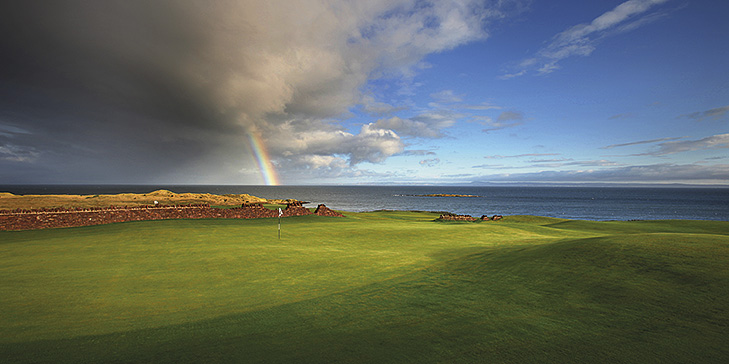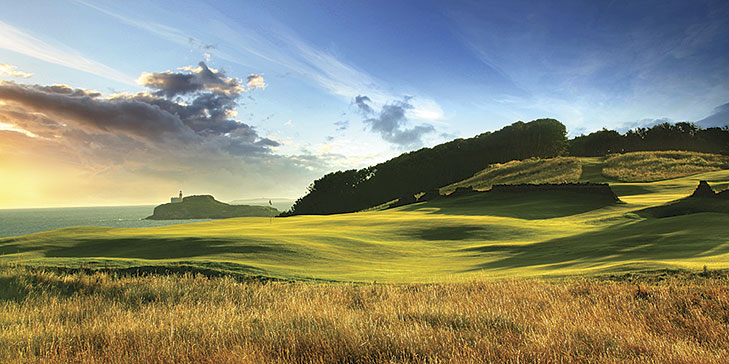Developing a high end golf club on one of the most famous coastlines in the game was never going to be a short-term project for Jerry Sarvadi. But the fact that his Renaissance Club on the Archerfield estate, right next to the iconic links of Muirfield is not only surviving, but thriving, despite five years of global economic turmoil, is testimony to the soundness of the decisions taken early on, and the quality of operation he runs.
“Opening in the teeth of the recession wasn’t part of the plan,” he accepts ruefully. “And it is true that we are not quite where I would have hoped to be by this stage. But we are financially stable, and we have continued to add members at a consistent rate for the last four years. I’d just like that rate to speed up a little now!”
Sarvadi might get his wish, as Renaissance is now close to taking its final shape. The clubhouse – which includes several bedrooms for the largely non-resident members and their guests – opened last year, albeit in the nick of time and only after Sarvadi himself had taken control over the final fitout after losing patience with the contractor he had employed. More rooms are available in the adjacent lodge. And now, what might be the last piece in the jigsaw – three additional holes designed by architect Tom Doak on duneland above the Firth of Forth, property that Sarvadi acquired from the Honourable Company of Edinburgh Golfers in a land swap before the club opened, but too late to be included in the original design – is in place.
“The new holes are really important,” Sarvadi admits. “Not only are they excellent golf holes in their own right, but they also connect the course to the coastline in a way it wasn’t before.” All golf developers know the value of coastal golf: architect Doak has wryly noted that his most highly ranked courses, Pacific Dunes, Cape Kidnappers and Barnbougle Dunes, have been the ones located next to the sea.


With the new holes, the course at the Renaissance Club now has more memorable moments
Not that there was anything wrong with the three holes that formerly opened the golf course. The long par three second in particular was a favourite of this writer. But the flow of the course is better now; it gets to the coastline, and the most exciting land, sooner, and it has more memorable moments.
Sarvadi agrees that building new holes so soon after opening the course was not an ideal sequence of events. “It would have been preferable if we had been able to do the whole course in one go,” he says. “But that’s not how it worked out – you have to play the ball as it lies in golf.” And it does, he points out with a smile, give the club another opportunity to hit the golfing headlines, which can’t hurt.
The Renaissance Club is run by Sarvadi himself; though he escapes back to his former home Florida on occasion during the Scottish winter, he’s generally to be found around the club most days, either playing golf, greeting members or ensuring the hospitality offered in the splendid new clubhouse is up to snuff. But his backers are a consortium of investors, each of whom bought shares in the development company. Isn’t answering to a group of owners a new form of purgatory for such a hands-on boss? He laughs. “All the investors bought in to the project on the understanding that they would have no influence on the day to day running of the club,” he says. “So far, that’s worked out fine. They come to visit and play, and they express views, but they know it’s my baby.”
And so to the new holes themselves. Two are par threes, one of which, playing westwards towards Edinburgh, has been named Arthur’s Seat by Sarvadi, given that the extinct volcano that sits in the heart of the city is a convenient aiming point for the hole. But it’s the par four tenth hole that will grab the lion’s share of the attention.
The tee for the tenth sits among dunes, at the top of a cliff above the Firth of Forth. Powerful golfers will be looking to hit their tee shot over the cliffs to shorten the route to the hole; for others, it is more of a sweeping dogleg to the left, to a green set hard against the cliff edge. It will be one of Scotland’s most photographed holes, and if, as is widely rumoured, the Scottish Open comes to Renaissance in the next few years, it will feature prominently in the coverage of the event. In fact, a forward tee for the hole could possibly be used in such an event, and would make the hole just about drivable for the professionals.
What stands out at Renaissance is the ‘clubbiness’ of the atmosphere. This is some achievement: Doak’s course is splendid, featuring typically bold greens; the par five seventh, with a large mound blocking the view of much of the green, and the epic par four eighth, whose green appears to climb a mountain, and is framed by an ancient dry stone wall, are perhaps the standouts. The standard of accommodation and hospitality is consistently high. But, even early in its life, the club has a pleasantly alive feel to it. “The balance of membership is about 40 per cent US, 30 per cent local and 30 percent elsewhere,” says Sarvadi. “That’s a little more locals than we had expected, but it does give the club a very authentic feel.” He’s right: unlike many of the newer, American backed courses in Scotland (Trump International, Loch Lomond, Kingsbarns to name but three, though obviously two are resorts), Renaissance is a year round club, and even in the dead of winter, when GCA visited, both course and clubhouse were busy and buzzy. Jerry Sarvadi may have a way to go before his dream is complete, but he has made a very strong start in his first five years.
This article first appeared in Golf Course Architecture - Issue 36.